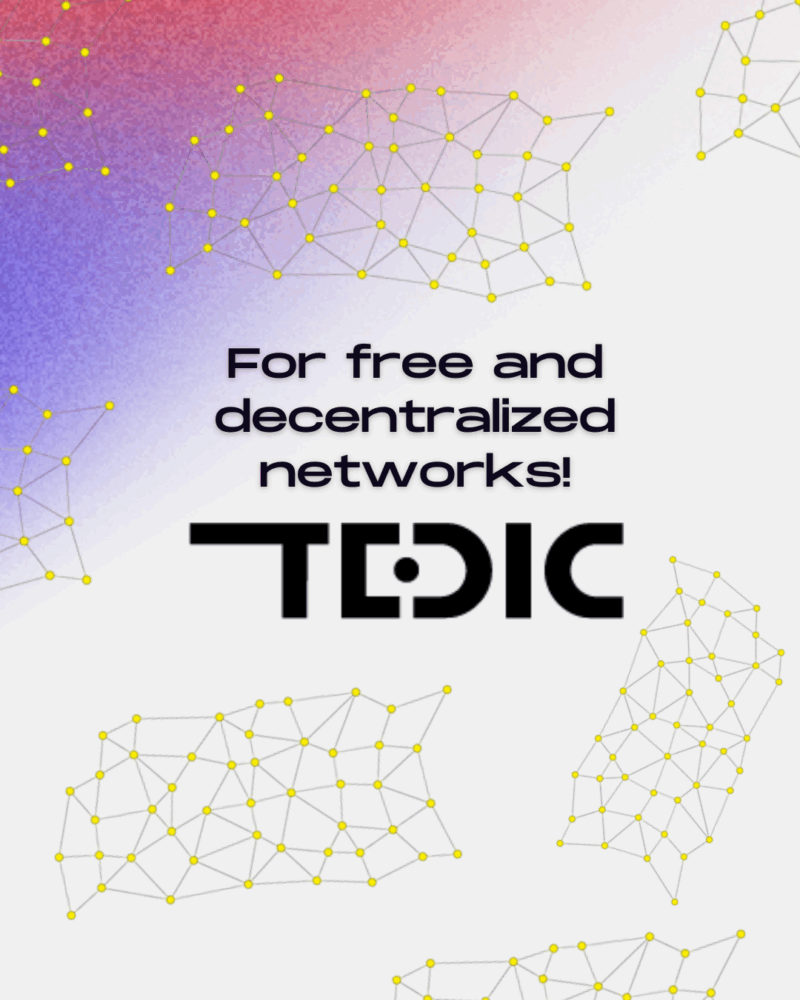
What are social media platforms if not a “place” to chat and share with the people you find important? They could be close friends, intimate acquaintances, people you’ve met, or even “famous” individuals. It depends on the type of profile you want—or are able—to build. You can choose to have a public or private profile, and in terms of sharing, you can show more or less of your everyday life or personal projects. In any case, always remember: what’s made public tends to stay there “forever” 1.
In this context, it’s interesting to explore how “commercial” or “corporate” social networks actually work. They operate under centralized control systems, based on algorithms created and governed by hierarchical structures. These structures are usually made up of a handful of wealthy white men living in the Global North: think Elon Musk and Mark Zuckerberg in the cases of X, Facebook, Instagram, and WhatsApp (which is somewhat of a hybrid between messaging app and social network). TikTok is a bit different since it’s a Chinese corporation, but in terms of control, it’s still centralized.
What does this mean? That what you see on your feed (or timeline) is not simply what your 300 friends or 2,000 followers want to show you or what you share with them. Instead, it’s a prioritized, filtered, and sorted list organized by algorithms based on your profile, the political and economic situation of your society, and the interests of these corporations. These platforms also determine whether your content complies with the “terms and conditions” imposed by the same companies.
This situation can be visualized like this:
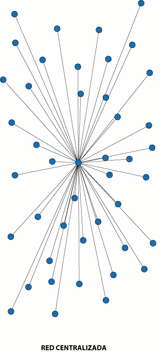
At the center of the diagram would be Zuckerberg (or Musk, Bezos, etc.) and their control algorithms. The nodes are people who, in order to communicate, must go through that control node. So, if the network owners don’t want you to share a woman’s nipple—but are fine with a man’s—you won’t be able to. If they think your content is antisemitic because you shout “Free Palestine!,” they might delete your post or suspend your account. Or if you want to promote your business but don’t pay for ads, very few people will see it. It’s not because they’re evil masterminds—it’s because they’re profit-driven and prioritize whatever yields the most revenue. If supporting LGBTQ+ groups was profitable yesterday, then they covered everything in rainbows—but if today that support threatens their business, they’ll delete any reference to the movement.
“They promised us connection,
but gave us addiction, surveillance, and manipulation”.
— Elena Rossini
So, some questions we could ask ourselves: Why on earth do we use platforms controlled by these capitalist moguls who only want to increase profits? How does this impact freedom of expression? When censorship occurs, what’s the due process to compensate victims? What happens to innovation and knowledge diversity? What happens in conflict situations—how do these corporations and their algorithms act? How do they influence the political landscape of societies?
In this article, we don’t intend to answer all those questions. Instead, we want to pull the first thread of a tangled web you can explore on your own—different ways of inhabiting the internet. There are social networks that aim to break the concentration of power and escape capitalist exchange logics. In terms of software and algorithms, these networks are built upon the political and philosophical foundation of the Free Software movement, which promotes the design and publication of programs that empower users and break monopolies of power 2.
Decentralizing Power
Going back to the question of power, it’s worth revisiting this diagram showing three possible types of networks: centralized (as discussed above), decentralized, and distributed 3.
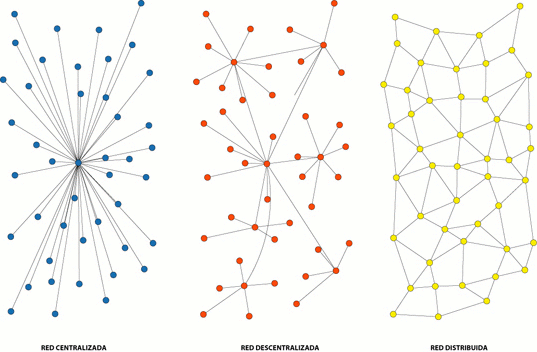
In this article, we introduce a set of free networks that operate in a decentralized manner using a communication protocol called ActivityPub 4.
Let’s say it’s a kind of “language” these networks use to talk to one another. The set of networks using this protocol is known as the Fediverse. In short: the Fediverse is a collection of decentralized networks that use free software and communicate via a shared protocol. Some of these networks include Mastodon, PeerTube, Pixelfed, and others 5.
What’s interesting about any of these networks is that they’re decentralized. Take Mastodon, for example: there’s no single address or owner. Instead, there are many “instances” of the network. Each instance is governed by a group or organization that sets its own “rules.” Here are three examples:
- https://mastodon.social with its details and rules: https://mastodon.social/about
- https://social.coop and its rules: https://social.coop/about
- https://mastodon.uy and likewise: https://mastodon.uy/about
Each instance has a community behind it, a number of users, and basic guidelines for coexistence. The challenge is choosing one with a community you’d like to be a part of. But the best part is that once you create your profile on a given instance, you can connect with any user or group—not just within your instance, but across the entire Mastodon ecosystem.
Interconnection and Diversity
And it doesn’t stop there. Let’s take another Fediverse network, like PeerTube, which is a decentralized video-sharing platform. It works similarly to Mastodon: there are multiple PeerTube instances, like https://tube.undernet.uy 6.
Your Mastodon profile can connect with people and organizations on this PeerTube instance. That means you’re not limited to profiles from your own instance or even your chosen type of network—you can connect with any profile across the Fediverse. Amazing, right? (See the image at the end of this article.)
Each Fediverse network has different features: some are for text, others for video, images, or even blogging. There are also many free apps available to use these platforms—since the protocol is open, there’s no “official” Mastodon app, but rather multiple apps that let you access your account and connect with others across the Fediverse 7. It’s a vibrant ecosystem with many options, the challenge is finding what fits your needs best.
In any case, it’s possible to move your data from one instance to another. For example, Mastodon lets you export all your posts and followers and import them into another instance. This feature is called “Move to another account”8. Finally, there’s a new network called BlueSky 9. It’s gaining popularity, but currently it’s not integrated into the Fediverse. It’s partially open and partially federated perhaps we’ll explore it in a future article.
In addition to the Fediverse link in the notes, we’ve also curated a non-exhaustive list of some free network profiles you can follow to start connecting once you choose your instance.

Or, if you prefer, you can start with jointhefediverse, which provides step-by-step instructions and a themed/regional list of Fediverse instances.
And last but not least, here’s a 4-minute video that explains everything we’ve covered: https://news.elenarossini.com/fediverse-video (with Spanish subtitles).
If you need more info or want us to dive deeper into any part of this ecosystem, reach out we’ll see you on the networks!
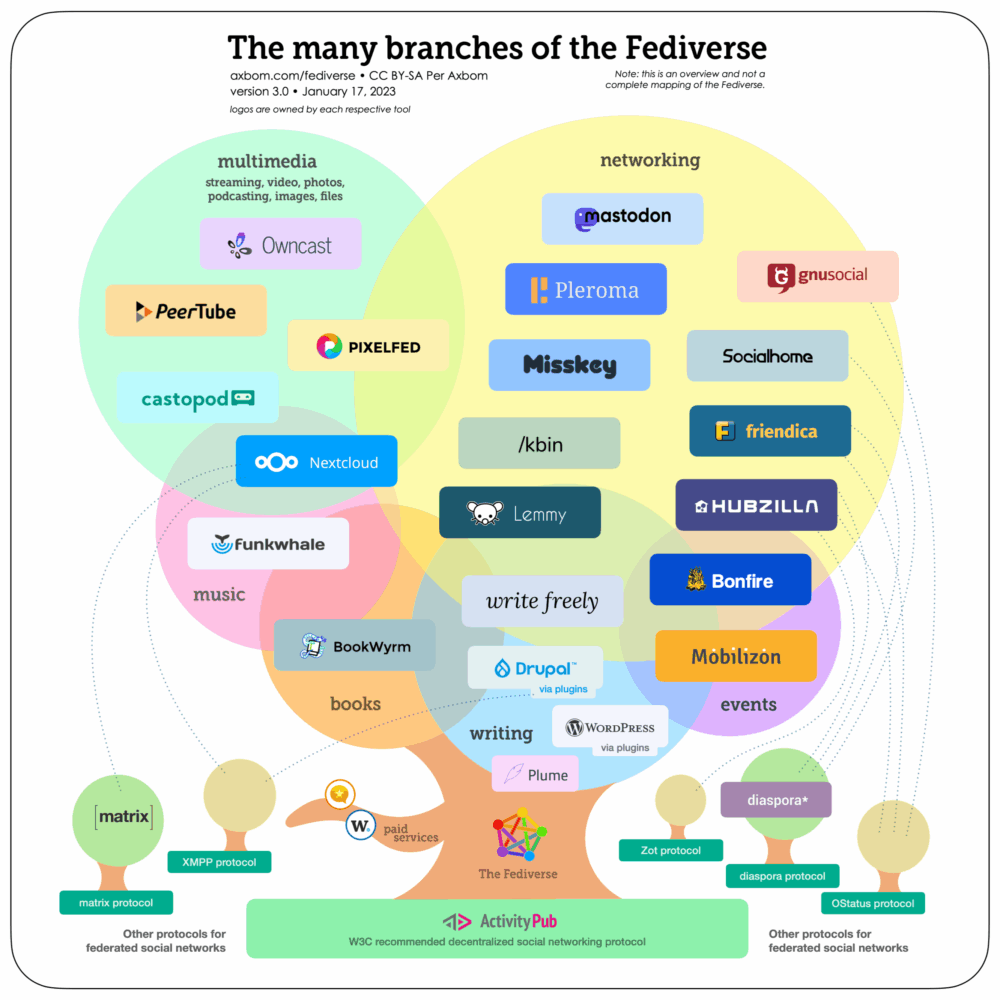
Notas:
- It might be a good time to revisit our “Care Kit for Dealing with Hate Speech” (in Spanish): https://cyborgfeminista.tedic.org/kit-de-cuidadosfrente-a-los-discursos-de-odioen-plataformas-digitales
- To learn more about Free Software, check out this short infographic we created a few years ago (in Spanish): https://www.tedic.org/flisol-15-festival-latinoamericano-de-software-libre/
- We’ve explored the issue of power distribution before in our article on Matrix/Element (in Spanish): https://www.tedic.org/matrix-element-la-mensajeria-del-futuro-ya-llego-parte-1/
- You can read more about ActivityPub here: https://en.wikipedia.org/wiki/ActivityPub
- You can find a complete list of Fediverse platforms here: https://fediverse.party
- With rules here: https://tube.undernet.uy/about/instance/home
- For Mastodon on Android, you’ll find: Tusky, Fedilab, Mammut, Twidere, and more
- Here’s a tutorial on how to migrate your Mastodon account: https://www.xataka.com/basics/como-migrar-tu-cuenta-mastodon-instancia-a-otra (in Spanish)
- Learn more here: https://en.wikipedia.org/wiki/Bluesky_(social_network)

 Our work in 2024 – Institutional Report
Our work in 2024 – Institutional Report 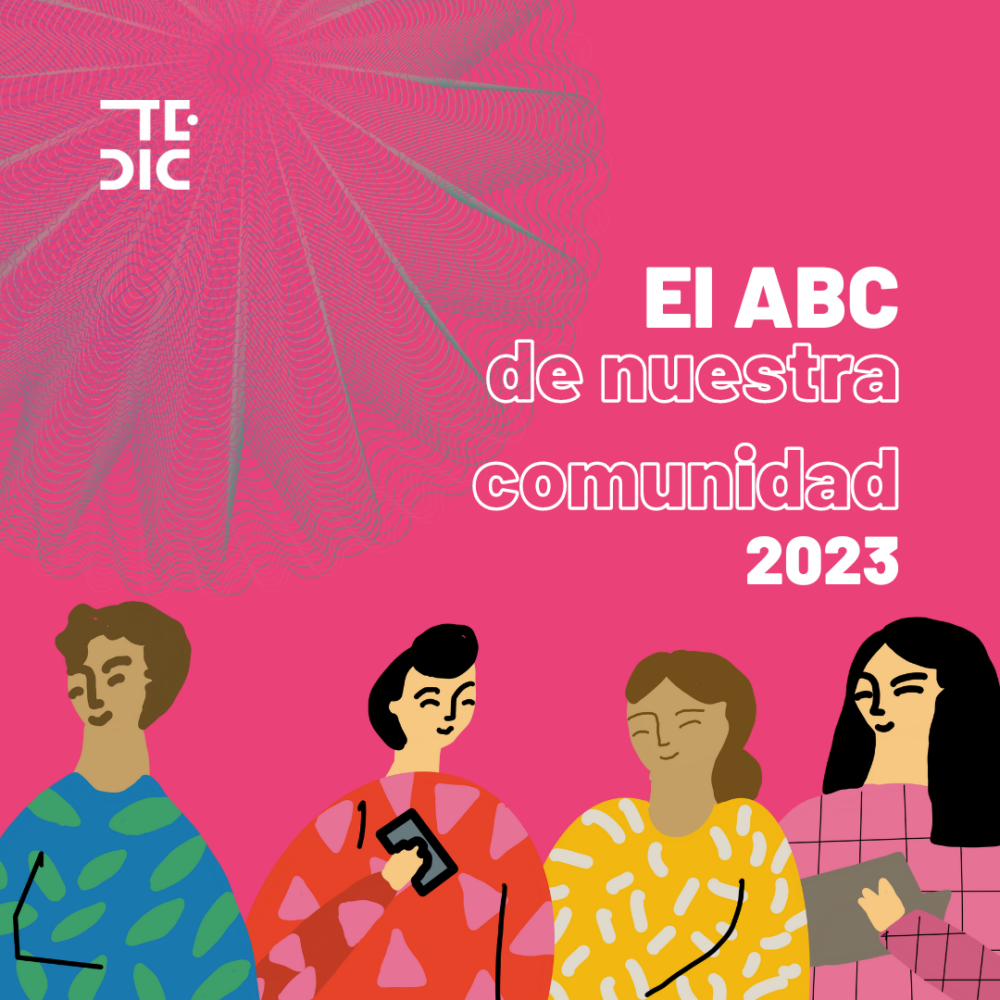 ABC of our community in 2023
ABC of our community in 2023